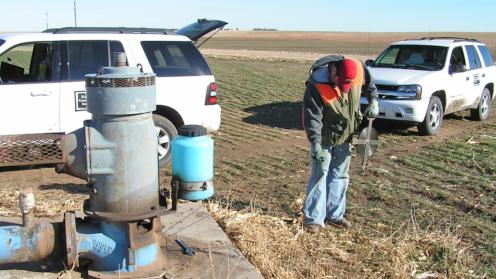LAWRENCE — A crew from the Kansas Geological Survey, based at the University of Kansas, along with staff from three field offices of the Kansas Department of Agriculture’s Division of Water Resources will be in western Kansas measuring groundwater levels the first week of January.
Levels are measured annually as part of a joint project to monitor the health of the state’s valuable groundwater resources.
Weather permitting, the KGS crew will be working near Colby on January 2, Goodland on January 3, Ulysses on January 4, Liberal on January 5, and Dodge City on January 6. DWR staff will measure wells in other parts of the region.
Brownie Wilson, KGS water-data manager, expects this winter’s measurements to show a general decline in the water table though not as steep as last year’s results.
“In several locations, 2022 was one of the driest years on record in Kansas and those prevalent drought conditions carried over into the spring of 2023,” Wilson said. “Fortunately, much of western Kansas saw gentle and widespread rains throughout the early summer months. This allowed a lot of producers to shut down their wells and reduce the pumping stress on the aquifer, especially in the Ogallala region of the High Plains aquifer in Kansas.”
The High Plains aquifer underlies portions of eight states. In Kansas, it encompasses three individual aquifers — the Ogallala aquifer in the western third of the state, the Equus Beds around Wichita and Hutchinson, and the Great Bend Prairie aquifer around Pratt and Great Bend.
South-central Kansas may prove an exception to the expected measurement trends.
“They missed out on much of those rainfall events, and unfortunately the drought conditions have been hanging on throughout the summer and fall,” Wilson said.
Most of the wells measured by the KGS and DWR tap into the High Plains aquifer, a massive network of underground water-bearing rocks and the main source of water in western Kansas. The rest draw from deeper aquifers or shallower alluvial aquifers along creeks and rivers.
Groundwater levels in much of the state’s portion of the Ogallala aquifer, especially in southwest Kansas, have been on the decline since water use started to rise in the mid-20th century. Dry years lead to increased water usage, primarily for irrigation, which in turn typically causes greater declines in water levels.
The KGS and DWR measure depth to water in more than 1,400 wells in 48 counties, primarily in January to avoid as much as possible skewed data associated with short-term declines caused by widespread pumping during the growing season. This year, the KGS will measure 577 wells, and crews from the DWR’s field offices in Garden City, Stafford, and Stockton will measure 835.
Wells are accessed with landowners’ permission, and many have been monitored for years, although new wells are added as older wells become inaccessible or to fill in spatial gaps in the monitoring network. The majority are within the boundaries of the state’s five groundwater management districts (GMDs), which are organized and governed by area landowners and water users to address local water-resource issues.
Historical annual measurements for each well are available on the KGS website. Results of measurements made in January will be added in late February.

